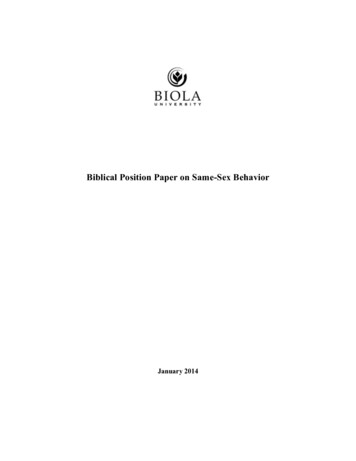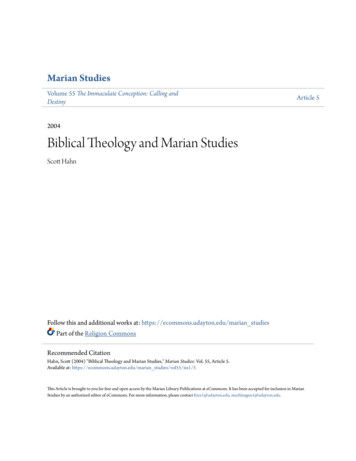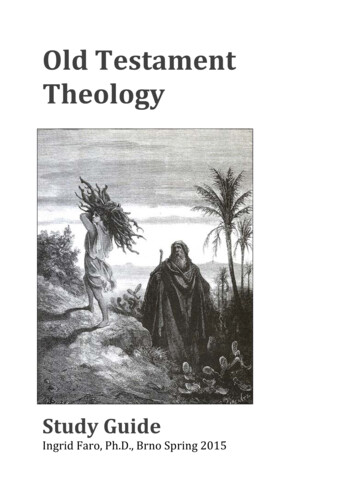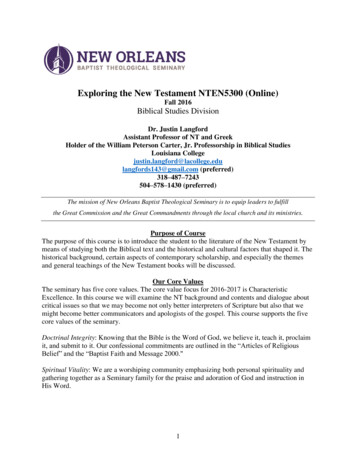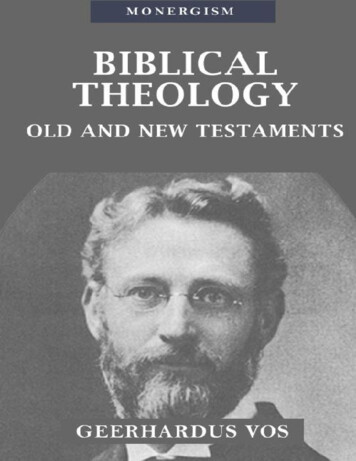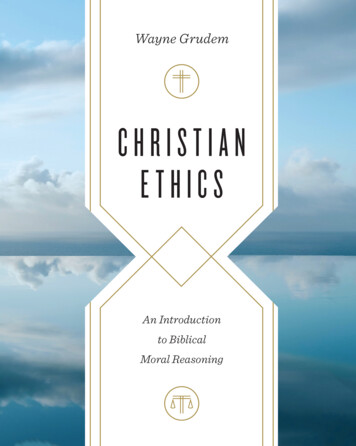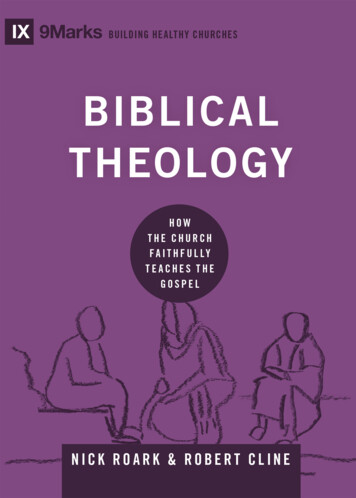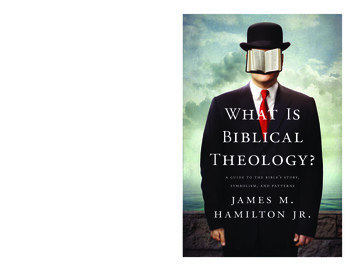
Transcription
1A New Testament Biblical Theology of Marriage and the FamilyExcluding DivorceMarvin J. Effa, Th. M., D. Min.Summer, 1987, Reviewed 2007Table of ContentsSection One, Foundational Issues . 1Section Two, Biblical Observations . 31 Corinthians 7:1-9 . 31 Corinthians 11:2-16 . 51 Corinthians 14:33b-38. 9Galatians 3:26-29. 12Ephesians 5:22-33. 13Ephesians 6:1-4 and Other Children Passages . 161 Timothy 2:8-15 . 181 Timothy 5:3-16 . 21Titus 2:1-6 . 23Hebrews 13:4 . 241 Peter 3:1-7 . 25Section Three, Concluding Applications . 29Section One, Foundational IssuesThis study will limit itself to the New Testament passages that relate to marriage or thefamily. Passages that involve the issue of divorce will be omitted. Passages in the NewTestament that are built from Old Testament quotes will also be omitted. This paper isnot intended to be a study of the role of the woman in the church, yet often the Biblespeaks to both subjects in one place. Where it is appropriate, interaction with the roles ofmen and women in the church will be included.The paper is divided into three sections: Foundational Issues, Biblical Observations, andConcluding Applications. Section one considers the presuppositions of this paper, sectiontwo is interaction with the text, and section three takes the form of a doctrinal statementto integrate the findings of the study.Few theological subjects reveal one’s hermeneutic more rapidly than the theology ofmarriage. Perhaps this is due to the pointed need the church feels today. Not only havethe issues of divorce and remarriage created concern, but entire denominations havedivided over the woman’s functioning in the church.The temptation is to approach the Bible as an answer book for twentieth centuryproblems. Groups with disparate interpretations both claim to base their beliefs on “whatthe Bible teaches.”Throughout this paper it will be assumed that the primary goal of interpretation is tounderstand an author’s intended meaning. The record he produced was superintended byGod in such a way that what he produced is authoritative, without errors, and intended by
2God to be binding upon any audience that shares the essential characteristics of theoriginal audience. Although the human author may not have intended his work to be readby more than his particular audience, the divine author did.It is also assumed that the present record of the New Testament is accurate. The variousbooks are each regarded as a unified piece of literature. Textual variants that relate to theformation of a theology of marriage and the family are insignificant. Where there aretextual problems preference is given to the Majority Text. In matters of theology thecredibility of the text becomes vitally important. One’s theology is usually determined bythe hermeneutic chosen. This is certainly the case with Elisabeth and Louis Tetlow. Theywrite:In approaching the text of Scripture, the scholar must sift out background andorigin of different words and phrases, and decide which of these reproduce earliertraditions, which are editorial comments upon traditions, and which arecompositions by the later writer. In this task it is necessary to utilize scientificmethods, such as literary, historical and redaction criticism. The process helps tosort the various types of material and, by understanding their origins and contexts,to interpret their meaning for Christians living today. 1This hermeneutic becomes the basis for dismissing 1 Timothy 2:8-15.It (1 Timothy 2:8-15) is post-Pauline, written by an author coming most probably,from a Pauline community but several decades after the death of Paul himself. 2This study assumes that the text is authoritatively binding upon the twentieth centurychurch. It is considered transcultural unless the author’s intention is to “localize” hismessage. An illustration of a message not intended to be transcultural is 2 Timothy 4:13,“Bring the cloak that I left with Carpus at Troas when you come.”3 It is not Paul’sintention to begin a “coat ministry” throughout the church age. He simply wants Timothyto bring his coat.The authors of the New Testament speak authoritatively to today’s church. Chapter 2provides interaction with important sections of their material.1Elisabeth and Louis Tetlow, Partners In Service, Toward a Biblical Theology of Christian Marriage(Lanham, Maryland: University Press of America, Inc., 1983, p. 42.2Ibid, p. 59.3The New King James Version. (Nashville: Thomas Nelson, 1982), 2 Ti 4:13, and so throughout the paper.
3Section Two, Biblical Observations1 Corinthians 7:1-9Now concerning the things of which you wrote to me: It is good for a man not to touch awoman. 2Nevertheless, because of sexual immorality, let each man have his own wife,and let each woman have her own husband. 3Let the husband render to his wife theaffection due her, and likewise also the wife to her husband. 4The wife does not haveauthority over her own body, but the husband does. And likewise the husband does nothave authority over his own body, but the wife does. 5Do not deprive one another exceptwith consent for a time, that you may give yourselves to fasting and prayer; and cometogether again so that Satan does not tempt you because of your lack of self-control. 6ButI say this as a concession, not as a commandment. 7For I wish that all men were even as Imyself. But each one has his own gift from God, one in this manner and another in that.8But I say to the unmarried and to the widows: It is good for them if they remain evenas I am; 9but if they cannot exercise self-control, let them marry. For it is better to marrythan to burn with passion.Outline:1. There are advantages to being a chaste single, 7:1.2. Marriage allows sexual needs to be met, 7:2-5.3. If one is not tempted sexually it may be best to remain unmarried, 7:6-9.Idea: Nothing solves sexual temptation better than marriage.Exposition:7:1In chapters 1-6 Paul had written to the Corinthians about matters he considered moreimportant than the answering of their questions. Now with chapter 7 he turns his attentionto the matters they asked about. Because of their present trials (7:26), his advice is that itmay be better for a person not to marry. That “good” does not mean morally better isclear from both this passage and the rest of the New Testament. Most commentators take“touch” as a euphemism for sexual intercourse. It seems, however, that this graphic termis hardly a euphemism. It is better to understand Paul as viewing the sexual relationshipas touch from beginning to end.7:2This verse restricts the meaning of verse 1. Even under their present distressfulcircumstances, marriage may be the very best route. Paul’s strong injunctions againstimmorality (i.e. 1 Co. 6, 1 Thess. 4:3) show the absolute necessity of moral purity.Marriage is the proper realm for sexual expression.7:3The husband is obligated to supply the sexual needs of the wife and the wife the sexualneeds of the husband. It is improper for either husband or wife to abstain from relations.This is the point he will argue in vs. 5.
4The terms Paul uses in vs. 3 view the conjugal responsibilities as a debt that is to be paidrather than a favor to be extended. His intent is to make each person in the marriage feelthe responsibility of supplying the needs of the other.7:4The wife is probably mentioned first because she was mentioned most recently in thetext.In marriage the rights an individual has upon his/her own body ends. Because of theresponsibilities toward one’s spouse on partner cannot say “My body is mine to do withas I please.” Equality of the sexes is stressed in this area of sexual satisfaction. Husbandand wife possess the same rights in this area of marriage.7:5The previous verses regarding one’s obligation are the basis for the strong terms usedhere. It is fraudulent for one to abstain from sexual relations with his/her partner. Thepresent imperative verb indicates that some were actually doing this. Husband and wifeare not to abstain. The only exception is when both agree to do so for a short time. Thereason for such mutual consent is to provide the time necessary to enhance one’srelationship with God. Anything other than this provides an opportunity to the Devil fortemptation.7:6The “this” probably refers back to verse 2. There Paul commanded that each man shouldhave his wife and each wife should have her husband. Some might take this as anabsolute command requiring everyone to marry. Paul does not intend it as such, as thisverse shows. If one chooses to marry there are obligations to be met. Even with all theextra responsibilities marriage brings, it may be the best choice for some. If possible,however, it is best to remain unmarried. This is the point of the next verse.7:7At this point in his life, Paul was unmarried. Perhaps he was a widower, but the evidenceis slight as to his previous marital experience. He was a member of the Pharisees (Acts.23:6) and may have also been a member of the Sanhedrin (Acts 26:10). Assuming that hewas in his early thirties at the death of Stephen, it is most likely that he was married. Wedo know that his Christian experience was as a single person.Paul received a spiritual gift from God that enabled him to be single and not tempted byimmorality. God does not will all to receive this gift of self-control.7:8There is nothing to be ashamed of if one is able to remain unmarried. In fact, Paul calls itgood. This is where he began in vs. 1. There are definite advantages to remainingunmarried.
57:9The general rule is that people do not have the gift spoken about above. This is not sin, itis an indication that they should marry. If one lacks self control the solution is marriage,for even with “the present distress” and the addition of marital responsibilities, it is betterthan unfulfilled passion.1 Corinthians 11:2-162Now I praise you, brethren, that you remember me in all things and keep thetraditions just as I delivered them to you. 3But I want you to know that the head of everyman is Christ, the head of woman is man, and the head of Christ is God. 4every manpraying or prophesying, having his head covered, dishonors his head. 5But every womanwho prays or prophesies with her head uncovered dishonors her head, for that is one andthe same as if her head were shaved. 6For if a woman is not covered, let her also be shorn.But if it is shameful for a woman to be shorn or shaved, let her be covered. 7For a manindeed ought not to cover his head, since he is the image and glory of God; but woman isthe glory of man. 8For man is not from woman, but woman from man. 9Nor was mancreated for the woman, but woman for the man. 10For this reason the woman ought tohave a symbol of authority on her head, because of the angels. 11Nevertheless, neither isman independent of woman, nor woman independent of man, in the Lord. 12For aswoman came from man, even so man also comes through woman; but all things are fromGod.13Judge among yourselves. Is it proper for a woman to pray to God with her headuncovered? 14Does not even nature itself teach you that if a man has long hair, it is adishonor to him? 15But if a woman has long hair, it is a glory to her; for her hair is givento her for a covering. 16But if anyone seems to be contentious, we have no such custom,nor do the churches of God.This passage deals with a problem that had arisen in the church over the womendiscarding their veils. It seems that they were doing this due to theological reasons basedon passages such as Galatians 3:28. If, as that text states, there is no difference betweenmale and female it does not matter whether women adhere to feminine attire or not. Inorder to demonstrate their freedom in Christ some of the women had begun a pattern thatcaused concern within the church. This particular problem is a localized cultural concernand not something the church is concerned about today. Within the passage itself Paulappeals to their sense of rightness by saying, “Judge among yourselves. Is it proper for awoman to pray to God with her head uncovered?” (11:13). In some countries this stillremains a concern, but not in Western societies.The discussion regarding the veil is based on the created differences between male andfemale. The masculinity and femininity concerns are an important teaching of thispassage.Outline:1. God gave the man and woman different positions, 11:2-6.a. God established different positions for men and women, 11:3.
6b. Men should be masculine, 11:4.c. Women should be feminine, 11:5-6.2. God gave men and women different roles, 11:7-12.a. God wants men to glorify Him, 11:7a.b. God wants women to glorify men, 11:7b-10.c. As Christians we are to depend on each other, 11-12.3. Keeping the genders distinct is the right thing to do, 11:13-16.a. Conscience says so, 11:13.b. Nature says so, 11:14-15.c. The churches say so, 11:16.Idea: spiritual issues do not blur gender distinctions.Exposition:With 11:2 Paul begins a new section that deals with corporate life, that is, issues that thechurch faces whenever they get together. The section continues from 11:2-11:40. thislarge section can be divided into two sections. The first dealt with a problem thatoccurred whenever they got together. The second dealt with problems that occurred onlywhen they came together for worship. As one moves in the second section (11:17) thephrase “come together” is repeated several times. This serves as a key that Paul is movingfrom general corporate life to the worship service proper.11:2This verse states that the church as a whole had kept the traditions established by Pauland provides an opportunity to praise them. With 11:17, however, he says that he cannotpraise them. The traditions mentioned in 11:2 probably refer to “faith and practice”passed on to them by Paul. Part of the tradition may have dealt with modesty. It does notseem that Paul is asking the women to begin covering their heads in contrast to theculture, but is urging them to continue to observe a cultural symbol that was appropriateto Christian theology.When necessary, Paul is not opposed to imposing Jewish cultural mores upon Gentiles(cf. chapter 14). It does not appear that this is an illustration of that.11:3The question in this verse is whether “head” means only source or whether it includes theconcept of authority and ruler-ship. Even if it means only “source” one still must ask thesignificance of this in the Apostle’s argument. Hodge may be correct when he says that“the obvious meaning of this passage is that the woman is subordinate to the man, theman is subordinate to Christ, and Christ is subordinate to God.”4 To say that the passageonly has “source” in view would leave some question as to the relationship of Christ andthe Father. The Father is not the source of the Son, although the Son clearly placedhimself under the authority of the Father.4Charles Hodge, Commentary on the First Epistle to the Corinthians (Grand Rapids, Michigan: Wm. B.Eerdmans Publishing Company, 1976), p. 206.
7The verse does not speak to husband wife issues, but to masculine and feminine issues.The head of the woman is the man . This does not particularly regard maritalrelations, but the relation between man and woman everywhere especially whereChrist is worshiped as Head, i.e., in the church. “Head” does not have an article,nor does “woman” have the indefinite pronoun “every.” That means that man’sheadship over the woman is not as absolute as Christ’s headship over all things.“The man,” not the husband of a woman, but every man, man as man. Of everyman it can be said that he is above the woman. 511:4A man dishonors himself when he adopts for himself things that the culture hasdetermined to be feminine. For a man to pray with his head covered then would besimilar to a man showing up at a Bible study wearing high heels and a dress today.11:5As it is shameful for a man to adopt feminine dress, so it is shameful for a woman tobecome masculine. Discarding her veil (her veil being a symbol of her femininity) placedher among those who shave. The word “head” is not in the last phrase of 11:5. Paul is notsaying that her head should be shaved, but that she has put herself among those who doshave.11:6If she wishes to no longer be feminine then she should also get her hair cut like a man.But if this is unacceptable to her, then let her hold on to all the symbols of her femininity,including her veil.In their culture it was quite easy to tell when a woman adopted masculine practices, forthe veil was a recognized symbol. In today’s culture things are not as clear. There arethings that are clearly feminine, but there is nothing masculine that has not already beenincorporated into the woman’s wardrobe or hair styles. Thus dress or hair styles becomesecondary to attitudes and roles.11:7Man ought to be masculine because of his position in creation. Man reflects the image ofGod differently than does the woman. God could have created Adam and Eve at the sametime and in the same way, but chose not to. Adam was created to rule and exercisedominion. He, not Eve, named the animals. Eve was created to correspond to Adam. Shewas created for him (11:9). As man reflects the image and glory of God, so womanreflects the glory of man. The woman is created in the image of man, for the term “glory”includes “image” as well.The essence of masculinity seems to be initiation. Femininity is responsiveness. A manwho leads and exercises dominion glorifies God. A woman who is responsive to the manglorifies the man.5F. W. Grosheide, The New International commentary on the New Testament, First Corinthians (GrandRapids, Michigan: Wm. B. Eerdmans Publishing Co., 1953), p. 250.
811:8-9The created order of man and woman reveal the divine intention. God created man andwoman for different reasons. The woman was created subsequent to the man and fromthe man so that there would be no misunderstanding as to the difference betweenmasculine and feminine.11:10It is entirely in keeping with Christianity for women to retain culturally acceptablefeminine symbols. Such a symbol shows her willingness (eagerness?) to be feminine asGod intended her to be. The reference to the angels has raised many questions. Perhaps itis included because of the similarity in temptations. The angels’ temptation was toabandon their positions for which they were created. The good angels accepted theirposition in the divine order and did not set out with Satan to find “greener pastures.”11:11-12The created order of man and woman provides responsibility and opportunity fornurturing not oppression. These two verses remind the man of this. “In the Lord” meansthat as Christians there ought to be no abusive oversight. God established (“all things arefrom God”) the mutual interdependence.11:13The section concludes with a variety of appeals to the “rightness” of men beingmasculine and women being feminine. The consensus of the group would be thatmaintaining masculine and feminine distinctions is proper.11:14-15The reference to nature probably means that Paul’s point is consistent with any culture ofany time. As a rule, men have always had shorter hair than women. For a man to keep afeminine hair style is not an honor to himself.The last phrase of 11:15 has been used to say that Paul intends the hair to be the coveringand therefore women could dispense with their veils. Such an interpretation would goagainst all that he has argued for. It is better to understand him to be adding yet anotherreason for the veil. If nature has provided the woman with a covering, it is certainly notinconsistent to hold to a feminine symbol that is also a covering.11:16Knowing that some would still argue over the masculine-feminine issue, Paul exerts hisapostolic authority. Understood in the verse is the thought that this is the way Christiansdo things, and if anyone wishes to remain a part of the Christian community they must dothings this way. It is not open for further discussion.The idea of the passage is that spiritual issues do not blur sexual distinctions. When aman becomes a Christian he does not become a woman. When a woman becomes a
9Christian she does not become a man. Masculinity and femininity are enhanced andencouraged by Christian theology. Any culturally acceptable distinctive should bemaintained by Christians.1 Corinthians 14:33b-38as in all the churches of the saints.34Let your women keep silent in the churches, for they are not permitted to speak; butthey are to be submissive, as the law also says. 35And if they want to learn something, letthem ask their own husbands at home; for it is shameful for women to speak in church.36Or did the word of God come originally from you? Or was it you only that itreached? 37If anyone thinks himself to be a prophet or spiritual, let him acknowledge thatthe things which I write to you are the commandments of the Lord. 38But if anyone isignorant, let him be ignorant.This section is part of a larger body of material that deals with problems that arose inconnection with the worship service. After resolving the problem of disorder at theLord’s Table, Paul deals with disorder in the worship service. The tendency of this groupwas to bring into the church worship forms familiar to their pagan, pre-Christian days. Asurvey of chapters 12-14 shows that Paul intends them to learn a new way of worship thatis free from the ecstatic states of their idolatrous ways.Survey of 1 Corinthians 12-141. As unbelievers they were involved in worship without understanding, 12:1-3.2. All the gifts are necessary to the body, especially the less honorable ones, 12:431.a. The Spirit sovereignly distributes a variety of gifts, 12:4-11.b. There is one body composed of may members, 12:12-14.c. Each member of the body is essential to the body, 12:15-27.d. Not all members of the body have the same gifts, 12:28-31.3. Love is more important than gifts because love outlasts gifts, 13:1-13.a. Gifts must be exercised in love, 13:1-7.b. Gifts will eventually be unnecessary, 13:8-13.4. Edification only happens as understanding is enlightened, 14:1-25.a. The church should desire gifts that edify the body, 14:1-5b. Edification requires understanding, 14:6-19.c. The church should grow up in its understanding of the importance ofunderstanding, 14:20-25.5. Edification of the body at the worship service requires order, 14:26-33a.a. Those addressing the body should take turns in their speaking, 14:26-33a.b. Women are to remain silent in the worship service, 33b-38.c. Allow the exercise of gifts, but do it orderly, 14:39-40.When the church gathered for worship, certain individuals claimed that God had movedthem to action and that such action could not wait. The result was confusion. Such
10confusion, assures Paul, does not come from God. In chapter 14, he enjoins a partialsilence on two groups of people (prophets and those speaking in tongues) and thenenjoins an absolute silence upon the women.Outline:1. The Corinthian church is to follow the established traditions of the other churchesPaul planted, 14:33, and 36-38.2. Women are to be silent as a sign of their submission, 14:34.3. The women are to seek spiritual instruction from their husbands at home, 14:35.Idea: As a sign of submission, women are to be silent during the worship service.Exposition:14:33There is some debate whether this section begins with 14:34 or 14:33b. “Taken with whatfollows the words are an appropriate reminder that this commandment is not given to theCorinthians alone but to all church.”614:34The term translated “silent” is used elsewhere in the passage (cf. 14:28 and 14:30). It isnot correct to take this as a reference to attitude or manner. In other passages relating tothe woman “quiet” may mean “silent” or refer to the woman’s manner. Here, however,the context would make such a translation difficult. The word translated “speak” is ageneral word that would certainly include other terms such as “teach, preach, evangelize,or herald.”The reference to “the Law” also saying the same thing that Paul has just said probablycomes from the Genesis 3:16 where the Lord said “Thy husband shall rule over thee.”“He draws the conclusion that the speaking of the woman in public is in contradiction tothe position assigned to her by the Divine will expressed in the law.” 7 Paul’s concernseems to be that for women to speak in the worship service does not demonstratesubmission.14:35This verse does not in any way discourage the education of the women. It assumes thatthey will wish to learn. If ever there were an appropriate time for a woman to speak in theworship service, one would expect it to be when gaining an explanation from herhusband. This too is excluded and delayed for the domestic interaction. The degree towhich it is unacceptable for women to speak in the church service is accented by the term“shame.” The term is used to refer to that which is ugly, deformed or of anything thatexcites disgust.14:366Grosheide, p. 341.Frederic Louis Godet, Commentary on First Corinthians (Grand Rapids, Michigan: Kregel Publications,1977, p. 739.7
11Although this passage violates the Corinthians’ sense of cultural correctness, Paul assuresthem that the practice he has outlined is proper. They are part of something God is doingaround the world and cannot keep unbiblical practices as if they should receivedeferential treatment.14:37Anyone in the church, claiming to be a spiritual leader will accept the Apostolic authoritywith which Paul writes. It is not the will of Paul that is the only concern in the worshipservice. It is ultimately the will of God. The commands concerning the proper way toworship God come from God. They are his commands.14:38An issue that is so contrary to culture will always have dissenters. To them Paul issues awarning. Those who intend to follow a path different than the one just given are free todo so, but they are not free to remain in the church. They are abandoned to theirinexperience and bare the responsibility for their theology. 8This passage has caused no little trouble among those who wish, on the one hand, toremain theologically conservative, and yet on the other, to not face the confrontationalheat of the American culture. Numerous attempts at making his passage less confrontinghave been offered. Typical objections are as follows:Objection #1: The genre relates only to a woman’s public exercising of her gifts.Counter: the problem with this explanation is that the terms used are very general. It is“speak” not “preach.” The argument Paul gives is simply that is it shameful for women tospeak in church.Objection #2: Because the passage in 1 Timothy 2 can be understood to mean “quiet”rather than “silent,” 1 Corinthians 14 should be understood to refer to the woman’sdisposition as well.Counter: The context helps us define the term in 1 Corinthians. In 14:30 the same term isused and clearly means silent. Else where in the New Testament the term means to “saynothing,” “become silent,” or “stop speaking.” The term used in 1 Timothy 2 can mean“quiet,” but it is also frequently used to mean “silent.” Therefore the terms are used tospeak to attitude, but go beyond attitude to physical silence.Objection #3: The genre relates only to the exercising of independent authority over theman. The argument is given that it is proper for women to speak in the service providedthey do so with the authority of the male powers that be.Counter: The trouble with such an explanation is that Paul excludes even the asking ofquestions. As a sign of submission, the woman is to even refrain from asking her ownhusband questions.8Godet, p. 745.
12Objection #4: since the primary problem in the Corinthian church was the disruption ofthe service, women are to be permitted to speak provided such speaking does not disruptthe service.Counter: It is certainly true that the problem was disruption of the service (as is also trueof the problems created by a disorderly use of the gift of tongues and prophecy). It is not,however, the identification of the problem that is difficult, it is Paul’s solution. In light ofthe appeals to both tradition and the practices of other churches, it seems that Paul intendsto not only solve a problem, but also call them to a commandment of the Lord for thechurch (14:3
formation of a theology of marriage and the family are insignificant. Where there are textual problems preference is given to the Majority Text. In matters of theology the credibility of the text becomes vitally important. One’s theology is usually determined by the hermeneutic chosen

